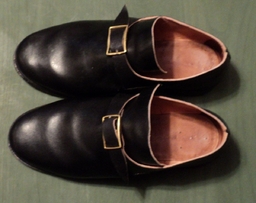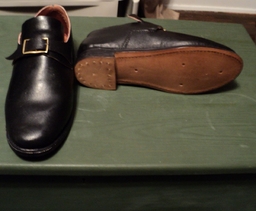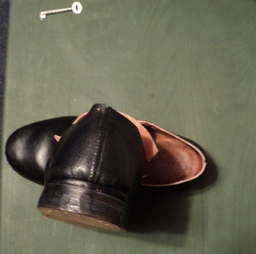-
Posts
248 -
Joined
-
Last visited
Content Type
Profiles
Forums
Events
Gallery
Everything posted by Brit.Privateer
-
From the album: 1706 Admiralty Slop Contract Shoes by Sarah Juniper
Note that the tonge is not absolutely huge like I've seen on some shoes and that the buckles are smaller ones that are the corret size and shape for the late seventeenth and early eighteenth centuries. -
From the album: 1706 Admiralty Slop Contract Shoes by Sarah Juniper
Bottom/sole view of the shoe. Notice that the shoes are straight lasted. -
From the album: 1706 Admiralty Slop Contract Shoes by Sarah Juniper
The most interesting part of the uppers construction that I've seen is that the upper part of the shoe (the part that has the latchet for the buckle) isn't sown on top of the other leather like I've seen on other pairs of shoes like this, but actually are joined together at the same level and do not overlap at all. -
From the album: 1706 Admiralty Slop Contract Shoes by Sarah Juniper
The heel uses hard wood pegs. The shape of the pegs is based on archaeological shoes discovered on the La Belle shipwreck of 1685. -
From the album: 1706 Admiralty Slop Contract Shoes by Sarah Juniper
It was common practice for period shoes to utilize a round closing on the rear of the shoe (which many reenactors call "butt stich", which is actually a reenactorism). The stitch is that vertical line in the rear of the shoe. -
A few of questions before proceeding: 1) What restrictions do you have on time period for this? 2) Are we just dealing with Atlantic and Indian Ocean pirates (no Barbary pirates of the Meditteranean)? 3) Are we counting prize ships that had pirate crews on them? Also, in terms of guns on a ship, we are only counting mounted guns (I am thinking of the Quedah Merchant here from Captain Kidd). 4) Besides counting guns, are we also looking at the size of crews? Beyond that, a couple other things you should consider. While saying "two decker" might seem simple, consider this. There is a difference between a proper gun deck and arming the spar/weather deck on a vessel. A "two decker" will actually have two proper gun decks that aren't the weather/spar deck. The other thing to think about is that the counts of guns differ greatly from source to source. Some count rail-mounted guns (like swivels) while others don't and only look at guns mounted in gun carriages. Now, without going off the top of my head, your largest pirate vessel is problably going to be either one of Bartholomew Robert's (I think he might have had a legitimate two decker, definately a one decker with a heavily gunned upper deck, I'll have to go read up on it again) or one of those Red Sea raiders in the 1690s or 1720s. Most of the large pirate vessels that come to mind to me don't go beyond the 40s in terms of guns (though watch, someone here will find that one example with 50 or more).
-

How can you call yourself a real Pirate re-enactor?
Brit.Privateer replied to TheBlackFox's topic in Captain Twill
Oh, good. I was thinking "well, that's bold to try and troll people who own sharp weaponry, firearms, and artillery." If it was a troll, it would have been a clever one. -

How can you call yourself a real Pirate re-enactor?
Brit.Privateer replied to TheBlackFox's topic in Captain Twill
in other words, Mission just did a I thought there was a troll about after I read that post, that's why I didn't get passionate in my post and stuck to critiquing the first of the three questions (since I could use history on it). -

How can you call yourself a real Pirate re-enactor?
Brit.Privateer replied to TheBlackFox's topic in Captain Twill
Question 1 has some issues. To be a pirate, you didn't have to rape women or even kill someone. There was no rule saying you had to do those two things or that it was even typical of a pirate. That's not to say some pirates didn't engage in those two, but not every women encountered by pirates was raped (unless you got a strange definition of rape) and there are plenty of ships they encountered in which they didn't kill anyone. -

Book Collection offered for sale on Amazon
Brit.Privateer replied to Island Cutter's topic in Thieves Market
Just grabbed the Wooden Ship book. I remember that one from when I was younger and thought it was amazing. Good price for it. You say you have other books that aren't listed? -
Remember how I asked about the C& D Jarnagin Shoes ( http://www.jarnaginco.com/1812%20footwear.htm ) and if anyone had seen them before? Well, I found a review of them: http://www.bilgemunky.com/pirate-reviews/clothing/early-18th-century-colonial-buckle-shoe/ I only wish there was a picture of the side of the shoe.
-
I was curious, what is the current status of period correct shoes for the reenacting community? As far as I know, the top ones are still: >>Sarah Juniper (UK) http://www.sarahjuniper.co.uk/ >>Andy Burke (UK) http://www.andyburke.co.uk/index.htm >>Loyalist Arms (Nova Soctia) http://www.loyalistarms.ca/shoesandsandals.html *Loyalist also offers the best period buckles too (they are actually the correct size). Just email them about it. I would put Reconstructing history, but their shoes aren't listed anymore on their site. Beyond, is there anything new out there for makers? As far as I know, all the other shoes out there are later 18th century shoes or English Civil War era shoes. Also, has anyone ever seen these shoes mentioned on this page called the " (Early 18th Century) Colonial Buckle Shoe"? I would love to see pictures: http://www.jarnaginco.com/1812%20footwear.htm
-

Pseudohistorical Re-enactment and Living Revisionist History
Brit.Privateer replied to Red_Dawn's topic in Beyond Pyracy
Read it, it really doesn't have solid evidence for what it argues. Some of the evidence he does present is questionable in terms of being valid as sources on this subject and he heavily dips into the literary interpretion of period publications (fictional or in that gray area of factual fiction) for his argument. That is the simplest analysis I can give for that book. It has its roots with all other kinds of pirate myths with the "pirates were free spirits and were rebelling against society and government and doing all this stuff to demonstrate their rebellion." Overall, Burg's writing gave me the impression that he had an agenda of finding evidence for his argument, rather than taking in all evidence in context and making conclusions. There is minimal evidence for homosexuality in the Royal Navy during the period, let alone pirate society. Reported cases of sodomy in the Royal Navy are so small that even if you multiplied the number of cases by...lets say ten so as to make up for unreported cases, it's still a small fraction of a percent of the greater maritime community. There were less than a dozen court cases for sodomy in the British Navy during the War of Spanish Succession in a navy that was in the 40,000 range at its peak. Also, the courts lumped in relations between two adult men and relations between an adult man and a boy. Once again, I see the issue of people trying to cast 20th and 21st century mindsets onto people of 200-300 years ago. And like so many other things talked about concerning piracy and mythology - we aren't saying it didn't happen, we are saying that it was far away from the norm to the point of being close to an anomoly. To tie back with the Pseudohistory aspect of the thread, this is kind of an example of it directly related to pirate history. Homosexuality and history has its waves of popularity in academic studies of history and in mainstream trade book history. It's been going on long enough now that many colleges have departments dedicated to its study (well, almost, I'm referring to the variously named gender studies departments that exist out there). It once again apeals to that "I didn't know history was like this, and it's more interesting than those high school text books told me! Its shocking and new, it must be true!" kind of thing I mentioned previously.- 18 replies
-
- general re-enactment
- revisionists
-
(and 2 more)
Tagged with:
-
I just went through and skimmed this entire thread agan to see what was discussed. I remember seeing this thread a long time ago, and I'm surpised to see it dredged up again. It's kind of interesting to see that the evidence concerning boots for sailors of the GAOP goes back to 2006! In fact, about 90% of this thread is from 2006. Some observations from that: -There is evidence for fishermen wearing a kind of boot for the 17th to 19th centuries. But, they are fishermen and the boots are work-specific tools that were several times the price of normal shoes. -There were riding boots during the GAOP but evidence for boots being a fashion statement for this period is lacking. -There is no written evidence that pirates who had boots wore them. There is very little evidence that pirates stole boots (there is just the one example listed above from 2011 as far as I know, and then that other story above that seems to have pirates mocking and torturing captives for not having them for riding horses...well that's really illustrative for this topic isn't it?) -There is only a couple pieces of pictoral evidence for boots during the GAOP at sea with sailors (specifically, some officer-looking man in two watercolors included with Duplessis' work "Périple de Beauchesne à la Terre de Feu, 1698-1701" - I am pretty sure that its an officer if I read the French captions I have to go with them; and the 1725 Spanish sailor kit illustration as seen here: http://www.piratebrethren.com/forum/viewtopic.php?f=11&t=260 ). Compare that to the hundreds of pictures of sailors during the period of sailors wearing shoes. -There is no real written evidence of sailors wearing boots while at sea. There is no written evidence that they owned a pair, compared to a lot of evidence for shoes. Conclusion: A sailor during the GAOP period wearing boots during this period cannot be called anything close to normal. A sailor with boots would be better described as an anomoly based on the evidence. As for pirates, the same thing. So, if you are looking to have an accurate portrayal of a pirate during the GAOP that represents what was common for pirates, stick with shoes. If you don't want to do an accurate and common pirate portrayal, then don't and do boots if you want to. To borrow what someone else said on this thread: Non is forcing you to be accurate and represent the norm for the period. There, I think I summarized the findings of the 420some posts in this thread thus far. I would say at least two thirds of those posts were just going around the same circle again, and again, and again, and again. Also, Foxe deserves a damn metal for sticking in there on those discussions. I know I wouldn't have been as nice or as patient.
-

Pseudohistorical Re-enactment and Living Revisionist History
Brit.Privateer replied to Red_Dawn's topic in Beyond Pyracy
Cults...Cults everywhere. Pseudohistory in terms of mixing in cult-like stuff such as freemasons and templars - thanks to cable educational channels - have been popularized in the mainstream. It's the "Jones-Da Vinci" syndrome I would call it. If it can be made to look exciting like something in a Indiana Jones film or Da Vinci Code book, the public will eat it up because it allows people to escape and imagine for just a little bit - plus people are attracted to "oh, history may be different than what they taught in school - but in a cool way!" The odds would say that someone who believes in this kind of stuff will eventually end up reenacting. The agenda and revisionism stuff - well people like myself in academia encounter that all the time. If it's valid revision, then following the argument and examing the footnotes should demonstrate why it should remain standing. But, if the book is agenda driven and/or written just for the purposes of trying to get something new out nothing, it will eventually fall, like that book about Jefferson that was linked. It's not a new thing by any means. People of diverse beliefs and on both sides of the political spectrum have written stuff that doesn't have a foot in reality. Just got to try and deal with it the best we can and steer people who are willing to learn in the direction of good scholarship. Trying to yell down the people who believe in this kind of stuff (let alone write it) isn't worth it - I would say that yelling at them for it might be the worst thing you can do because some will convince themselves that such persecution demonstrates that they are right. Just let them get out what they want to say, tell others that are legitimately interested in learning why that position is wrong (preferably when that person isn't around so a fight doesn't start and make everyone feel awkward), and if an actual discussion comes around that involves that person - just try to be respectful as possible and don't get dragged into a passioned argument (for some people just want that - some just want the drama). For my personal experiences in this, I got plenty of it when I was a Civil War reenactor, and especially when I did my undergrad at Gettysburg College. You can guess what kind of stuff I encountered in those situations. Frequently, those events are large enough that those kind of people can be avoided.- 18 replies
-
- general re-enactment
- revisionists
-
(and 2 more)
Tagged with:
-
Intriguing...the one thing that catches me is that I don't think everyone absolutely clings to their anchors exactly like the next person does. I suspect that some people cling to them more than others. Meanwhile, I feel like some people can train themselves to not cling to "anchors" as much. Take me for instance, I loved pirates when I was a kid. I did so until about age nine, and then started pursuing Civil War stuff. At about age 13 I slowly became interested in the Age of Sail and maritime stuff (specifically, I started reading naval fiction from Forester and O'Brian), and my real interest in pirates returned at about age 17. But, when I returned to pirates, I approached it from as academically as possible. I didn't feel hindered by "anchors". I was quick to see that the pirates of my childhood and in fiction books and movies were of another universe altogether and not the real ones. I didn't feel like it was difficult to get over, in fact I was enthralled with the new perspectives on pirates that I discovered since these pirates appeared to be real for a change (unlike those in the previously mentioned fictional universe). Now, does that mean I didn't have anchors in the first place, or am I just an anomaly, or is there some context here I have not considered yet? Now, to tie this back to the thread topic of Treasure Island, what "anchors" might the book and movies establish in someone?
-
That's interesting a website said that about the eye patch thing. I suspect the site was confusing "Treasure Island" (1950) with "Return to Treasure Island"(1954)/"Adventures of Long John Silver"(1955) since they both have Robert Newton in the same role (exact same everything for that matter for Newton, accent, clothing, etc). Also, what was the theatrical reference I made (theatrical means stage productions like Pirates of Penzance right)? It's interesting that you don't want to read the story yet. That book was my favorite book as a kid, and I read it several times. I don't feel like it has impaired my perspective of pirates to the point of not allowing me to see facts for what they are. I would encourage anyone to read it. Read it, if not for the good story, for a better understanding of public perceptions of piracy. For Guy Ritchie, if you don't like the movie when comparing them to the original source material, fine, completely understandable. But, when considered outside of the source material, I still think the Sherlock Holmes movies are entertaining. For re-imagining the Treasure Island story for Guy, I don't mind since he wouldn't be the first. The 2001 and 2012 versions did that already. Some predict that Guy Ritchie will take the film in a darker and grittier direction. Honestly, I wouldn't mind seeing that interpretation, just to see how doing that changes the characters. I think that many of the pirate characters have the potential for being good in such a interpretation. Imagine if you took the pirates from the very intimidating 1950 version that I mentioned before and put them in a grittier environment not held back by Disney - I think you would see some astounding stuff.
-
For the eye patch thing, I think if you look at old cartoons from the 40s, you'll find pirates with patches (example, Popeye and Pirates, 1947: [http://www.youtube.c...?v=d3jXM7rUotY] ). Also, I believe that the Captain Kidd film from 1945 had them too (not a hundred percent on that). I also could have sworn there was a secondary character in one of the Captain Blood sequels during the 1950s that had an eye patch, if not one of those other campy-ish pirate films that came out in that decade. Also, there is the character "Patch" from the Adventures of Long John Silver television show (with Robert Newton as Long John Silver) in 1955 (plus a movie to go with it). So I would say mid 20th century is when the eye patch started getting associated with pirates. I think the two came together eventually because of the stereotype with old disable sailors wearing eye patches (I would post a link, but the one I want to use won't work when I put it in here). When you bring to mind a pirate with one leg like Long John Silver...maybe the two got mixed together by association. I only wish I had kept this one image I scanned from 1820 that had a Greenwich pensioner with an eye patch, one wooden peg/leg, a hook for a hand, a crutch, and wearing a bicorn hat. I saw it and said "that looks like a modern pirate stereotype". Anyway, the film. If you want exposure to the actual story of Treasure Island, the best thing beyond reading the book is the Turner 1990 version with Charleton Heston and Christian Bale (at age 15 at that point). That version is the closest to the book. The Disney 1950 version completely cannibalizes the beginning by reducing what is a few chapters (important ones) to under 5 minutes. They make Billy Bones nothing like he should be. Also, thanks to this cut down, we never see Jim's mother. Also, there are plenty of screw ups and things left out in other parts of the film too. The 1990 version covers much more, though isn't perfect either (the 1990 version adds some stuff, specifically some unnecessary stuff during fighting). Here is a list of all the relevant versions of Treasure Island that are out there now (and aren't meant for kids like cartoons or Muppets) in chronological order with what some interesting points after each one: 1934 Version: Has Wallace Beery as Long John Silver and Jackie Cooper as Jim Hawkins. -Lewis Stone as Captain Smollet is my personal favorite for that role, since his good character acting gives you the best feeling of someone who was a captain from the Royal Navy. -Since clothing stereotypes weren't as locked into stone yet, there are some interesting clothing choices in here that gives you the feeling that someone looked back at illustrations from the 1740s and from the "Crier and Hawkers of London." -The Weaponry used (except the way out of time period cannon on ship) look to be operational flintlock, maybe even old flintlocks originally from the 18th and early 19th century. -Beery as Silver I think captures best that ability of the original character to capture the trust of Hawkins and that look that author Stevenson described as "He was very tall and strong, with a face as big as a ham - plain and pale, but intelligent and smiling." 1950 Version: Has Robert Newton as Long John Silver and Bobby Driscoll as Jim Hawkins. -Newton as Silver is the best balance of looking trusting/friendly and angry/intimidating that is out there. -Driscoll as Hawkins I think is the best job done by a child actor in any of these films, but he seemed a bit scrawny for the role of Hawkins (I think he was kind of small for his age, he was 13 when he filmed this). -The pirate crew here is probably the most intimidating set in any of the films. They really do give off that "I've murdered people and I'm not intimidated by anyone" feeling. The guy who plays Israel Hands I think demonstrates this the best when he goes after Hawkins. He is also the best Israel Hands in any of these films. If this weren't a Disney film, I would have loved to see what they would have done with these pirates - for they felt held back because of Disney. -The Squire Trelawney/Dr. Livsey pairing in this one has to be the most amusing of all the films I've seen. 1972 Russian Version "aka Ostrov Sokrovishch": -This is definately a harsher world that any of the other ones portrayed. -Ben Gun is awesome in this one, he's more of a tough survivor rather than a crazy person. -Billy Bones doesn't die of alcoholism in this one, he goes down fighting, like a tough guy, which is awesome. -It's just interesting to see a non-American or English version take on this story. 1972 Version with Orson Welles as Long John Silver: -The only really appealing thing with this version is that Orson Welles is in it, but I feel like its the weakest portrayal of Long John Silver I've seen - as in he looks easily cowed at times. 1990 Version with Charleton Heston as Long John Silver and Christian Bale as Jim Hawkins: -This is the best adaptation of the story to film (or to a TV movie technically, but this film is done so well its hard to tell that it was originally meant for television) -Best fight scenes I've seen in these Treasure Island films (especially the realistic fight at the beginning between Billy Bones and Black Dog) -Best actors for Blind Pew (Christopher Lee) and Billy Bones (Oliver Reed) I've seen of all these movies. -The actors who did Squire Trelawney and Dr. Livsey are probably the most realistic among the films -Heston as Silver is probably the most intimidating Silver of all the films. -Hawkins in this film is probably the most reasonable age for this film to work, for any younger makes it seem physically impossible (Bale was 15 years old, but could have passed for a few years older I think). -The pirates of the film are pretty good and blood thirsty, but seem a tad too easy to cow by Silver (then again, it is Charleton Heston). -Probably the most realistic version of Ben Gun in all the films. 1999 (or 2001, conflicting dates on IMDb and Wiki) with Jack Palance as Long John Silver: -Not much to say on this film other than its the first major live-action and serious version to drastically deviate from the book. It completely changes the ending, with everyone except Hawkins, Ben Gun, and Silver dead, and they all go away with the treasure happily ever after. Its the first version to kind of say that "piracy isn't all that bad." -Also, its one of the first versions to use a notably older Jim Hawkins (older that 15 years old anyway). 2012 Version with Eddie Izzard as Long John Silver: -Made for TV, the Izzard approach to Silver as more of a plotter who is frustrated by inept followers is kind of refreshing. -There are plenty of deviations of from the original story material, including ones that give more screen time to a couple of female roles. -The clothing and characters definately gives this version a more "international pirates" feeling, for there seem to be a lot of influences from all different cultures here, especially seen in costume. By the way, the costumes are outright...strange is the best way to describe them. -The moral of the story and how they deviated from the characters/plot of the original create some interesting reimagining of some characters and different conclusions than previous. The most astounding changes are to Squire Trelawney, Dr. Livsey, and Ben Gun (played by Elijah Wood). And, there may be another version in development for 2014 with Director Guy Ritchie at the well (the direct of the recent Sherlock Holmes films): http://screenrant.co...d-contr-176380/
-
For the ship, I suspect that it was out of a desire for a good set to do action. Fairbanks was well known for his gymnastics he did on the screen - hopping, jumping, and climbing amazing distances. The tall stern castle allowed for a lot of that (especially climbing) and also allowed for that last scene where his men lift him through hatches all the way up to the top deck. In addition, the large ship allowed for large areas to fight and to fit the large crews. In fact - since I've yet to see any other film available that is older than Black Pirate - this film might be the so called "trope setter" for all the other films in the future for the use of big ships. Big ships = big areas for combat. For the soldiers, the only explanation I can come up with is that Fairbanks' character planned out the whole last action after he returned to land. He planned to make the boat look like it was sinking and all his men drowned, but in reality were swimming to the pirate ship. So maybe it was supposed to be part of the plot that the soldiers were specially dressed for the mission. In practical movie terms, those outfits are probably cheaper than other costuming they could have provided, and are more functional for the physical actions they are engaged in (the climbing and fighting and so on). For the boat, it wasn't a viking boat really (wrong construction for one), and it had a cannon on the front. It was designed to carry a lot of men and purpose designed to sink. Also note that it had a cannon the front. One has to remember that in the 20s and 30s that there weren't a lot of people who would yell "inaccurate!" like today. That was the case for a lot of films set in foreign lands outside of the U.S. or Europe. As long as the sets and props looked good and fulfilled what the director wants, then they built it. Just like the late 19th and early 20th century painters either borrowed things from other times/places or just outright invented things to create the image of pirates that we have today - movie people could do the same thing. At the most, a movie might try to create what an audience imagines a particular place or time looked like. I'm glad to see people still finding this film and enjoying it. Hopefully you were using one of the DVD editions of it released by Kino. Kino digitally restored the film, made sure the film was at the right speed (ever notice how some silent films seem to be slightly fast - that's because the transition from silent to sound resulted in changes in film speed, and sometimes the silent films got played on sound film speeds), and had the correct musical score to go with it. I have it in blu ray, and the higher quality helps even more (believe it or not). Be careful of other editions, for it's been put into plenty of $5 or lower DVD racks and in pirate film compilations in it's low quality form (no color, wrong music, wrong speeds) because its public domain. As suggested above, if you want to learn more about the film, obtain one of the Kino editions that has the film historian Rudy Behlmer commentary on it.
-
Interesting article, and it contains a few pictures from the Álbum de Construcción Naval del Marqués de la Victoria. I've linked it on this site once before: http://www.armada.mde.es/ArmadaPortal/page/Portal/armadaEspannola/ciencia_museo/06_documentacion--02_archivo--01_del_deposito_hidrografico--coleccion-marques-victoria People have been talking about this source on this forum and other pirate forums for years, see Pirate Brethren Forum back in 2006: http://www.piratebrethren.com/forum/viewtopic.php?f=11&t=260 We have a high quality pic for half of the one involving clothing: http://www.piratebrethren.com/spanishsailornotes.gif Somewhere there is the other half, but I can't find the link. But beyond that, no one has anything else available so far that isn't low quality. I've been trying to find it myself - for they did a 1995 reprint of this book (very limited printing). Only four libraries in the whole United States hold this book. If you ever see it on sale, even if its hundreds of dollars, it's worth its weight in gold.
-
Right on. You would think the shrapnel would be the main killer, but no, the explosion creates such a shock wave that anyone within at least 25 feet is either dead or severely damaged by internal bleeding/hemorrhaging (not sure what the correct term is). If you look at the first video, you see that cardboard square with the foil circles - those test for that, and they get blown out real quick. Those of you who watch the Mythbusters may be familiar with them from some of the tests concerning shock waves.
-
It hasn't been published as far as I can tell. It's a rather specific kind of thesis in terms of publication. As for being available somewhere, it wasn't among that large collection of thesis papers that Texas A&M put online.
-
Ah, it's good to see someone replicated this. One of my associates here at East Carolina University just told me about the original recently, and about the person who did a thesis paper on it and recreated them for live tests. The project got a lot of attention at the conference they revealed the research. Apparently, the deadliest thing about this is the shockwave from the explosion. They suspect this particular firepot was intended for use against the Spanish in mines in the southwest. Imagine the damage from this firepot when thrown down a mineshaft! Here are a couple of those tests they did with replicas:
-
Wow, my guess at the price was spot on! I am on the edge of ordering, but I have a couple of questions about being put on the list (and I suspect others will too): -Is this cash up front? -Does the nail that goes through the eye come with> -What are estimates for the completion of this? Based on the first post in this thread, it sounds like it will occur in sometime during or after October. Really accurate looking pike. I went and looked at the rest of your items, such as boarding axes, and they look real accurate too. How did I miss your website before this?
-
It looks real interesting. Curious though, in the picture you have in the link, what is the book behind it? I am interested in the book since that particular pike is not in the Whydah artifact catalogs I've seen (although the ones I saw were the earlier editions, which makes me all the more interested). Based on the picture that is in the book in the picture, it looks real good. Also, what cost are we looking at (I am guessing at least $120)? Are you doing just the head or do you provide the wood shaft as well?






